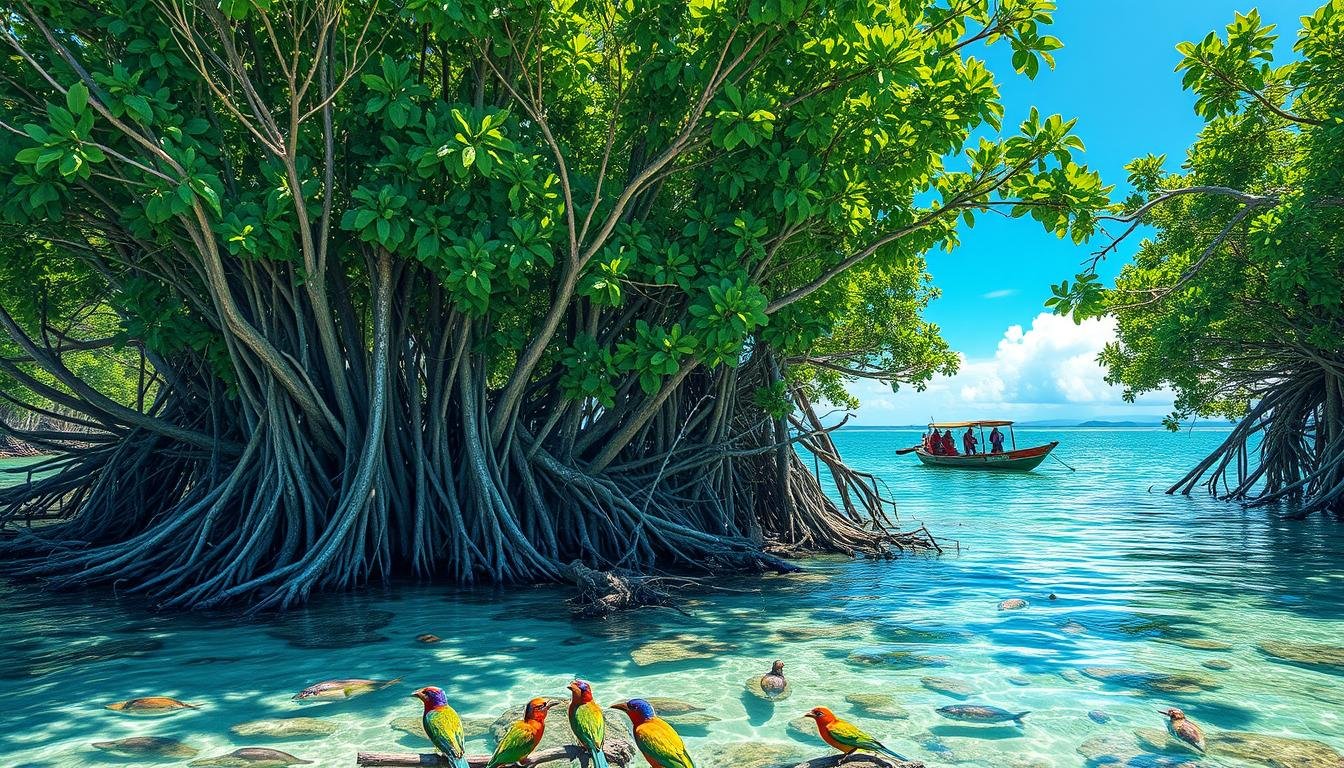What role do mangroves play in our ecosystem? They are key for coastal areas, giving homes to many species and shielding us from disasters. The Philippines, with its vast coastlines and rich life, has a lot of mangroves. These forests are vital for our planet’s health and must be saved for our future.
The Philippines has lost 10.5% of its mangroves from 1990 to 2010. The government is working to save them, with plans to plant 1.5 billion trees, including mangroves, by 2028. Yet, mangroves face threats like deforestation, climate change, and pollution. These dangers harm the balance of mangrove ecosystems.
Key Takeaways
- Mangroves are essential for coastal ecosystems, providing habitat for various species and protecting against natural disasters.
- The Philippines is home to a significant number of mangrove ecosystems, covering approximately 256,185 hectares in 2000.
- The country has lost 10.5% of its mangrove forests between 1990 and 2010.
- The Philippine government has allocated funds for the Mangrove and Beach Forest Development Project.
- The National Greening Program aims to plant 1.5 billion trees, including mangroves, from 2011 to 2028.
- Mangroves play a vital role in keeping our environment balanced.
- It’s important to protect mangrove ecosystems for the health of our planet and communities.
Introduction to Mangroves
Mangroves are key to coastal ecosystems, giving many benefits to both nature and people. They live in warm, salty areas worldwide. With over 54 true species, mangroves are diverse and vital for conservation.
They can keep a lot of salt out, and their roots help them breathe in low-oxygen places. Mangroves grow in coastal zones between 25 degrees north and south. Some can even grow up to 32 degrees north in the Atlantic.
Definition and Characteristics
Mangroves live in salty, coastal spots and have special roots. Some can grow really tall, while others stay small. Their unique traits make them important for coastal ecosystems and conservation.
Global Distribution of Mangroves
Mangroves exist in over 118 countries, with 50% in Southeast Asia. The Philippines has a lot of mangrove forests. These forests are essential for coastal ecosystems and conservation.
Unique Biodiversity of Philippine Mangroves
The Philippines boasts a wide variety of mangrove species, with about 35 true mangroves. This diversity is key to the ecosystem, supporting many plants and animals. It’s vital to conserve mangroves to protect this biodiversity and keep these ecosystems healthy.
Mangroves are essential for the ecosystem. Their roots filter pollutants and trap sediments, helping coral reefs and seagrass beds stay healthy. Yet, mangroves face threats like deforestation and climate change, making conservation efforts critical.
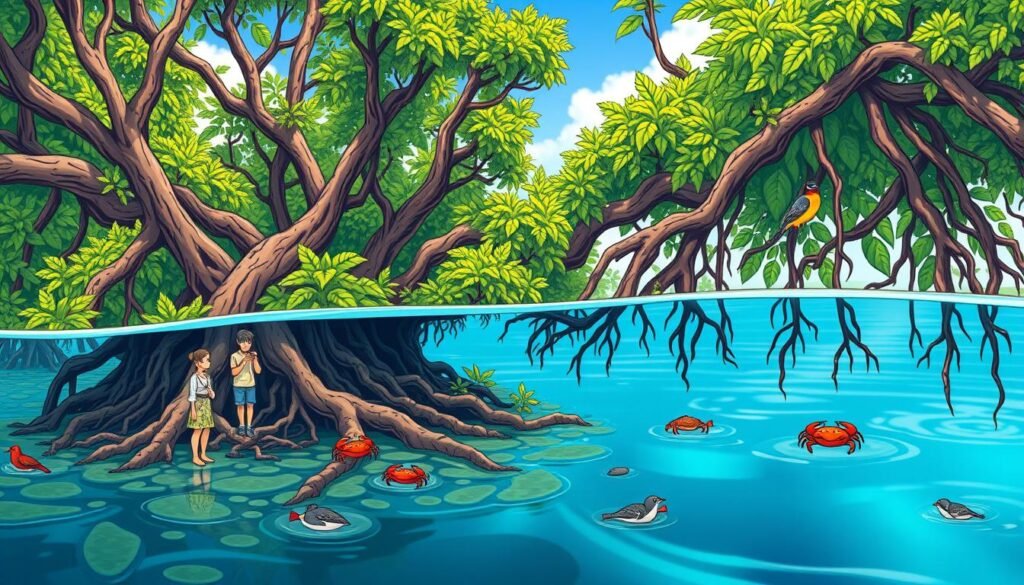
Species Diversity in Mangrove Ecosystems
Mangrove ecosystems are home to a vast array of species, from tiny microorganisms to large mammals and birds. Saving this biodiversity is key to the health of mangrove ecosystems and the species that rely on them. Protecting mangrove forests and restoring degraded habitats is vital for preserving Philippine mangrove biodiversity.
Endemic Species Found in the Philippines
The Philippines is home to many endemic species found nowhere else. These species are a vital part of the country’s biodiversity and play a key role in the ecosystem. Protecting these species is necessary to preserve the unique biodiversity of Philippine mangroves, which is essential for the ecosystem’s health and the species that depend on it.
Ecosystem Services Provided by Mangroves
Mangroves are key to supporting our environment and protecting coastal communities. They offer many services, like storing carbon, protecting coastlines, and improving water quality.
Some important services mangroves provide include:
- Carbon sequestration: Mangroves help fight climate change by storing carbon.
- Coastal protection: They shield coastlines from erosion and storms, reducing disaster risks.
- Water quality improvement: Mangroves filter water, trapping sediments and pollutants.
These services are vital for our environment and protecting both humans and wildlife. By saving and restoring mangroves, we ensure their long-term health.
The value of mangrove services is huge, with some places earning over $10,000 per hectare yearly. Here are some key economic benefits:
| Ecosystem Service | Economic Value |
|---|---|
| Carbon sequestration | $77 per hectare per year |
| Fisheries | $213 per hectare per year |
| Coastal protection | Substantial, but not quantified |
In summary, mangrove services are critical for our environment and coastal communities. By saving these ecosystems, we protect our planet for the future.
Economic Significance of Mangroves
Mangroves are key to the lives of people living by the coast. 80% of the global fish catch depends on these areas. They help with fishing, tourism, and jobs that last.
Here are some of the main benefits of mangroves:
- They support a wide range of life and are homes to endangered species.
- They have healing properties that can ease pain and help with diabetes.
- They protect communities from storms and erosion.
- They clean the water by trapping sediments and pollutants.
A study on coastal conservation shows mangroves are vital to our economy. They offer many services that help people and the planet. Saving mangroves is essential for our future.
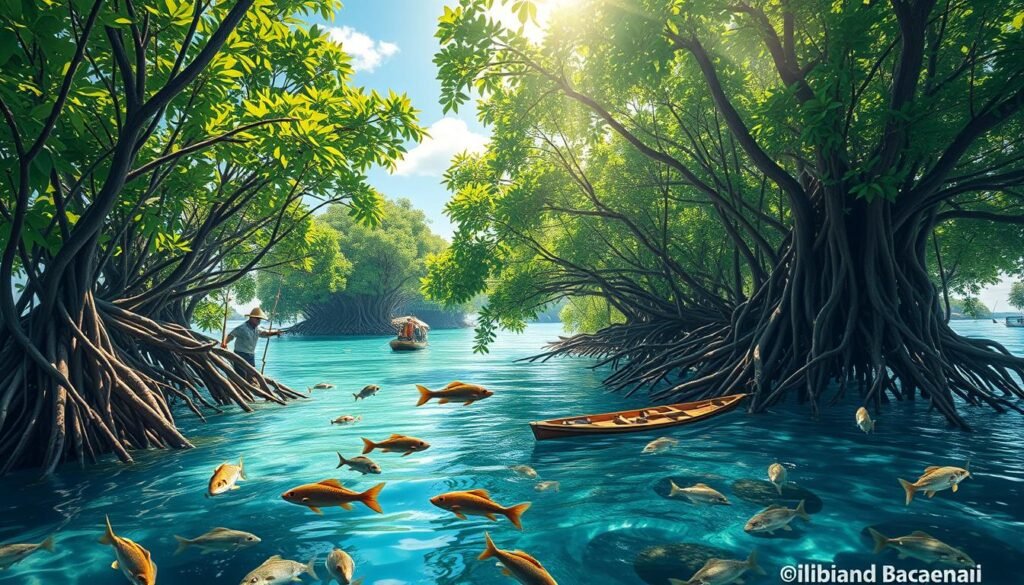
Supporting coastal conservation helps protect these important areas. We can do this by restoring mangrove forests and promoting jobs that care for the environment.
| Benefits of Mangroves | Description |
|---|---|
| Support for Fisheries and Aquaculture | Mangroves are homes to many fish and shellfish, helping coastal communities. |
| Ecotourism Opportunities | Mangroves offer a unique place for tourists, boosting local economies. |
| Sustainable Livelihoods | Mangroves provide many services that support people’s lives, like food and jobs. |
Threats to Philippine Mangroves
The Philippine mangroves face many dangers. Deforestation and land development are big problems. These activities destroy mangrove forests for urban areas, farming, and other human needs.
Climate change is another big threat. Rising sea levels and more frequent, intense storms harm mangrove ecosystems. Pollution and poor waste management also affect mangroves.
Some statistics show how serious the issue is:
- More than 600 mangrove trees have been lost in Manila Bay because of a new airport in Bulacan.
- The mangrove cover along Manila Bay has dropped from 54,000 hectares to less than 500 hectares.
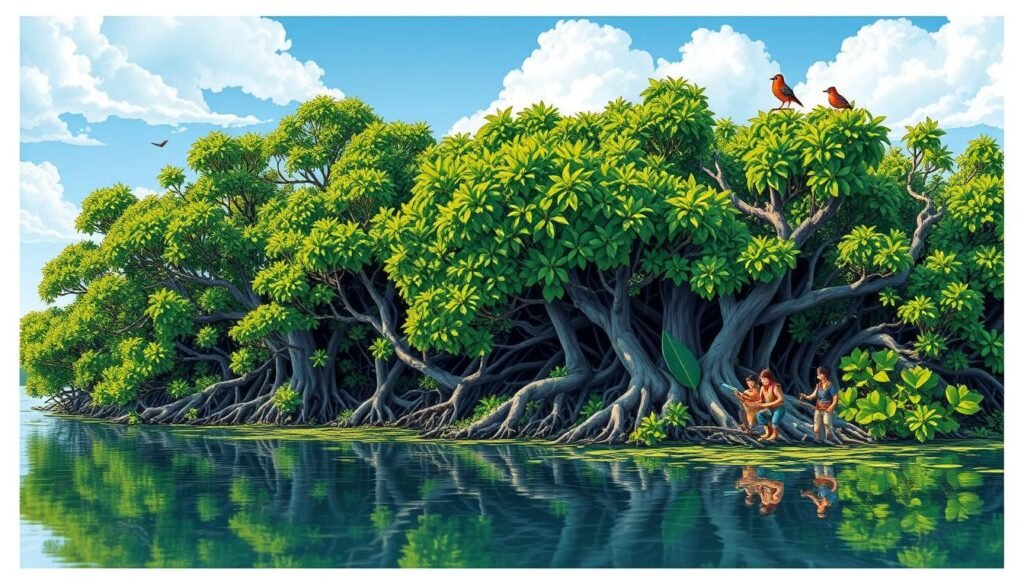
Efforts to save mangrove forests are underway. This includes planting new trees and protecting existing ones. But, more action is needed to protect these vital ecosystems.
| Year | Mangrove Forest Area (hectares) |
|---|---|
| 1918 | 500,000 |
| 1990 | 247,000 |
| 1995 | 794 |
| 2023 |
Conservation Status of Mangroves in the Philippines
The Philippines has 39 mangrove species. But, these ecosystems face threats like deforestation, climate change, and pollution. This makes mangrove conservation in the Philippines very urgent.
Protected Areas and Initiatives
Many protected areas and initiatives aim to save mangroves in the Philippines. For example, the Verde Island Passage is a marine protected area. It’s home to diverse marine life, including mangroves.
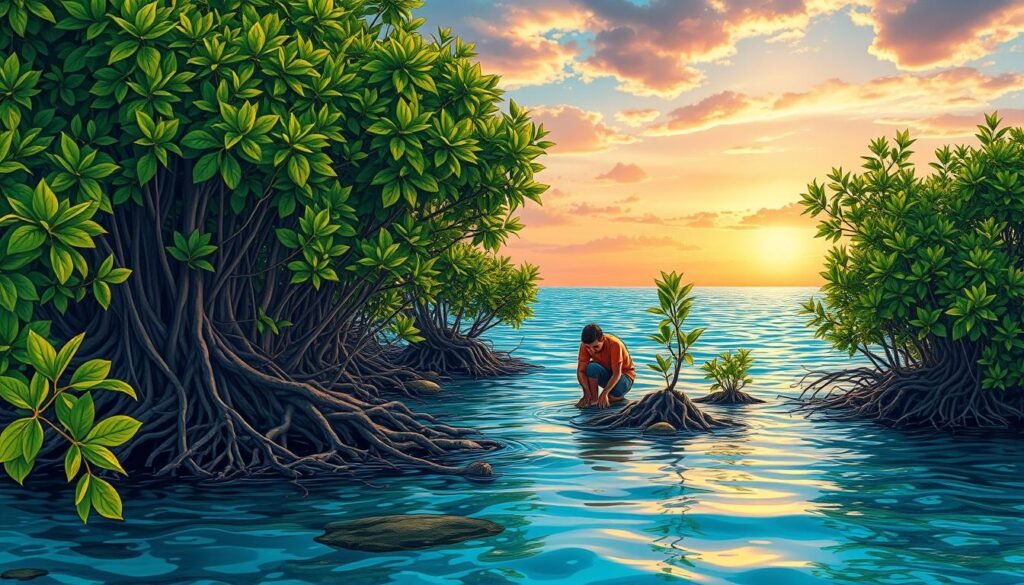
Role of Local Communities in Conservation
Local communities are key in mangrove conservation. They use and manage mangrove ecosystems. Their help is vital for conservation success.
- Planting and maintaining mangrove forests
- Monitoring and enforcing protected areas
- Providing education and awareness about mangrove conservation
Government Policies and Regulations
The Philippine government supports mangrove conservation with laws. The Philippine Environmental Code and the Wildlife Resources Conservation and Protection Act are examples. These laws help protect mangrove ecosystems and their inhabitants.
Restoration Efforts and Best Practices
Mangrove ecosystems are key to our environment’s health. Restoration is vital to fix damaged mangroves. From 1996 to now, about 1,100,000 hectares of mangroves have been lost worldwide. Around 818,300 hectares can be restored.
Restoring mangroves boosts coastal strength, fish populations, and biodiversity. The best methods involve working with local communities. This approach has shown to make restoration efforts last longer and be more successful.
Key Factors in Successful Restoration
- Community engagement and participation
- Inclusive ecological restoration approaches
- Use of native species and appropriate planting techniques
- Monitoring and maintenance of restored areas
Following these best practices can lead to better mangrove restoration. This helps our ecosystem and environment. Many groups, like governments and NGOs, are working together to restore mangroves.
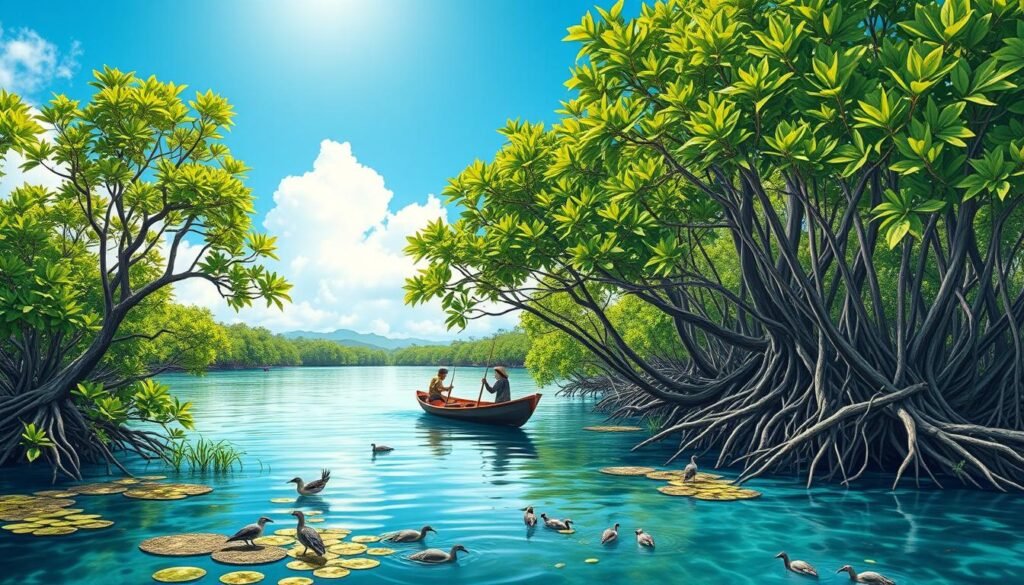
Mangroves are homes for endangered species, helping our biodiversity. We must keep restoring mangroves to protect them and our future.
| Restoration Approach | Success Rate |
|---|---|
| Single-species mass tree-planting | Low |
| Inclusive ecological restoration | High |
| Community-based ecological restoration | Very High |
The Role of Mangroves in Climate Change Mitigation
Mangroves are key in fighting climate change. They act as big carbon sinks and help many living things and people. The environmental benefits of mangroves are clear, showing their big role in fighting climate change.
In conservation, mangroves are very important. They help take in a lot of carbon, which can help lower greenhouse gases. Some main benefits of saving mangroves include:
- Carbon sequestration: Mangroves can take in up to 1,000 tons of carbon per hectare, making them top carbon sinks.
- Coastal protection: Mangroves can cut wave energy by up to 75%, protecting against storms and other dangers.
- Biodiversity conservation: Mangroves are home to many plants and animals, and saving them is key for healthy ecosystems.
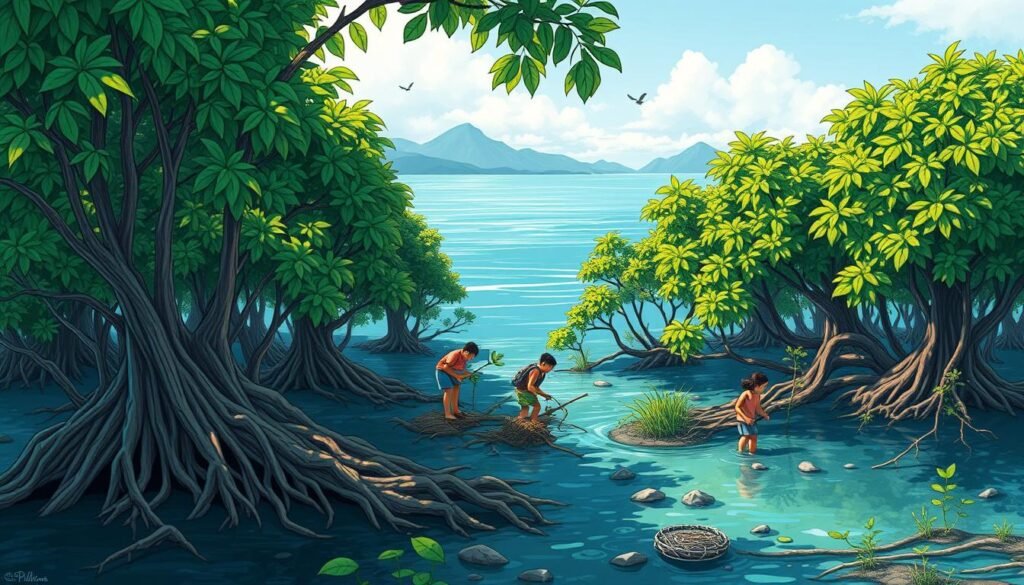
Mangroves play a big role in fighting climate change. By helping to save and restore mangroves, we can lower greenhouse gases, protect coastlines, and keep these important ecosystems healthy.
| Benefits of Mangrove Conservation | Description |
|---|---|
| Carbon Sequestration | Mangroves can sequester up to 1,000 tons of carbon per hectare |
| Coastal Protection | Mangroves can reduce wave energy by up to 75% |
| Biodiversity Conservation | Mangroves support a wide range of plant and animal species |
Traditional Knowledge and Mangrove Management
In the coastal ecosystems of the Philippines, traditional knowledge is key to mangrove management. For centuries, indigenous communities have lived in harmony with these ecosystems. They have developed unique practices and techniques to conserve and sustainably use mangrove resources.
Combining traditional knowledge with modern science is essential for effective mangrove management. Local ecological knowledge and scientific research together make conservation efforts more targeted and successful. For instance, indigenous communities know which mangrove species are vital for fish reproduction. This shows how important it is to preserve these ecosystems.
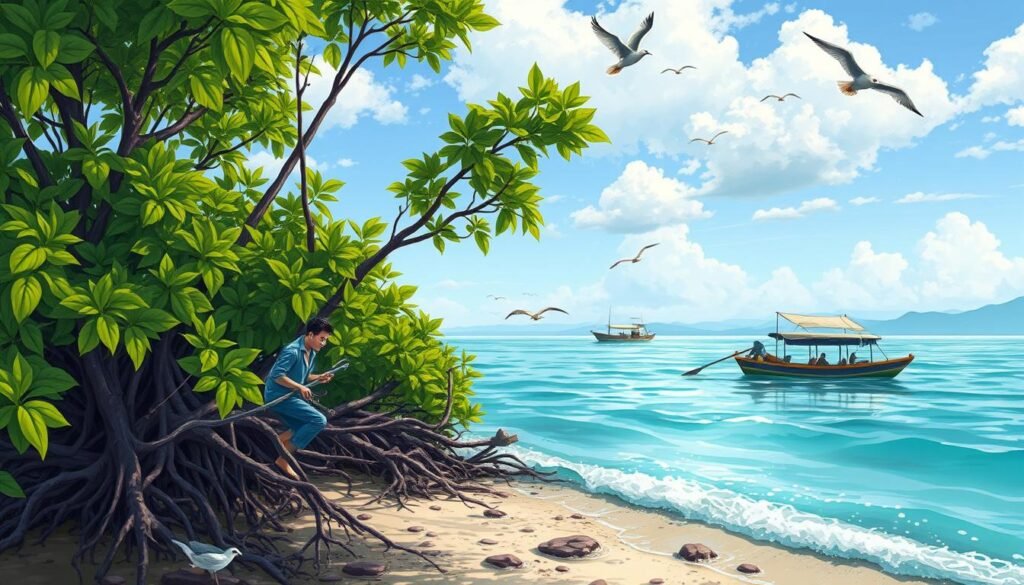
Successful mangrove rehabilitation depends on empowering local communities, giving them legitimate resource-use rights, and management responsibilities. Supporting indigenous traditions and involving local communities in conservation efforts is vital. This way, we can work towards a more sustainable future for these vital ecosystems.
Many countries have seen successful mangrove conservation projects. These projects have restored lost mangrove forests and created educational trails. These trails help promote cultural connections to these ecosystems. By learning from these experiences and adopting a more integrated approach, we can protect these critical coastal ecosystems for future generations.
Education and Awareness Initiatives
Education and awareness are key for saving mangrove ecosystems. They help create good management practices and get local communities involved. In the environment, education is vital for conservation and using natural resources wisely.
Many efforts aim to save mangroves, like the “Restoration of the Mangrove Landscape” project. It helped restore over 200 hectares of mangrove forests. Over 93 young people and 11 teachers and parents joined in, learning about conservation.
Some notable programs include:
- Community-led restoration initiatives
- Environmental education programs
- Advocacy campaigns to raise awareness about the importance of mangrove conservation
NGOs play a big role in advocacy and education. They help spread the word about mangrove conservation and support community efforts. Together, we can build a culture of conservation and protect our environment for the future.
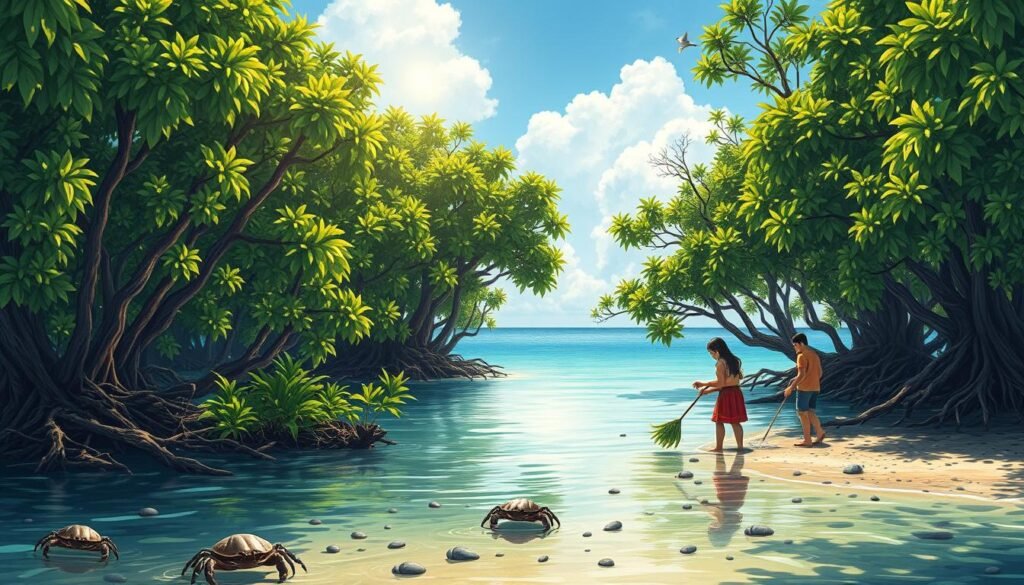
| Initiative | Objective | Outcome |
|---|---|---|
| Restoration of the Mangrove Landscape | Restore 200 hectares of mangrove forests | Over 200 hectares restored, with community engagement |
| Environmental education programs | Promote conservation awareness among local communities | Increased awareness and community participation in conservation efforts |
Mangroves and Coastal Resilience
Mangroves are key to keeping coastal areas healthy. They protect us from big storms and hurricanes. A study shows that mangroves can cut wave strength in half, showing their value in keeping us safe.
Mangroves also help many species and support jobs. They are homes for fish, birds, and more. In Ghana, losing mangroves hurt fishing and tourism, showing why we must save them. Learn more about mangrove conservation efforts.
To make our coasts stronger, we must save mangroves. We can do this by planning better, working together, and fixing damaged areas. Sea Water Solutions, for example, plans to plant 200,000 mangrove seedlings in Ghana.
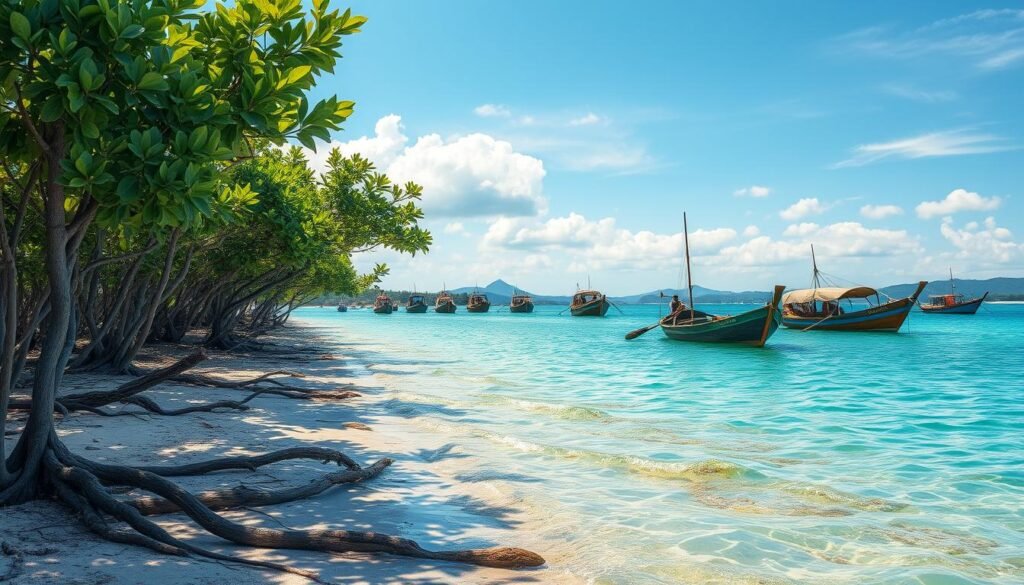
Protecting mangroves helps us face disasters, keeps nature rich, and supports local jobs. General Martin Delgado’s fight for his people and land shows the value of our natural world. Learn more about his story and the importance of protection efforts.
Future of Mangroves in the Philippines
The Philippines has a lot of mangrove species, with over half of the world’s 65. But, mangrove areas have been shrinking, down by 10.5% from 1990 to 2010. This loss is a big threat to our environment and the ecosystem services mangroves offer.
Yet, there’s hope for a better future. Mangroves help protect our coasts, improve water quality, and even absorb carbon. The Philippine government is working hard to save mangroves. They’re setting up protected areas and involving communities in conservation.
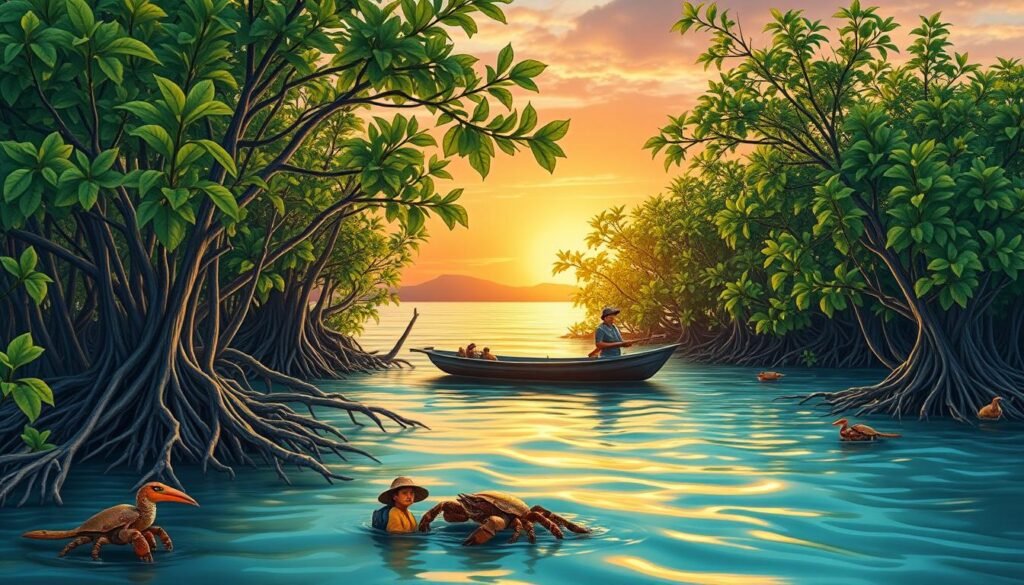
To face the future, we must support sustainable mangrove management. This means conservation, research, and working with local communities. The International Union for Conservation of Nature (IUCN) calls mangroves “nature’s superheroes” for their many benefits.
| Year | Mangrove Coverage (hectares) |
|---|---|
| 1918 | 500,000 |
| 2000 | 256,185 |
| 1994 | 120,000 |
In summary, the future of mangroves in the Philippines is uncertain. But, there’s a chance for a sustainable future. We must work together to protect mangrove ecosystems and our environment.
Mangroves in Policy and Planning
Mangroves are key to coastal ecosystems, giving many benefits like protecting shorelines and improving water quality. They also support a wide range of species. Yet, their value is often missed in policy and planning. The Global Mangrove Alliance says saving mangroves is vital for reaching sustainable development goals.
It’s important to include mangroves in urban planning for conservation. We can do this by making policies that help manage mangroves well. For instance, Manila has started to plan its city with mangrove conservation in mind. This is thanks to Daniel Burnham, an architect who shaped the city’s design.
Some key benefits of saving mangroves include:
- They protect coastlines from erosion and storms.
- They are homes for many fish and shellfish.
- They help fight climate change by storing carbon.
- They support local jobs and economic growth.
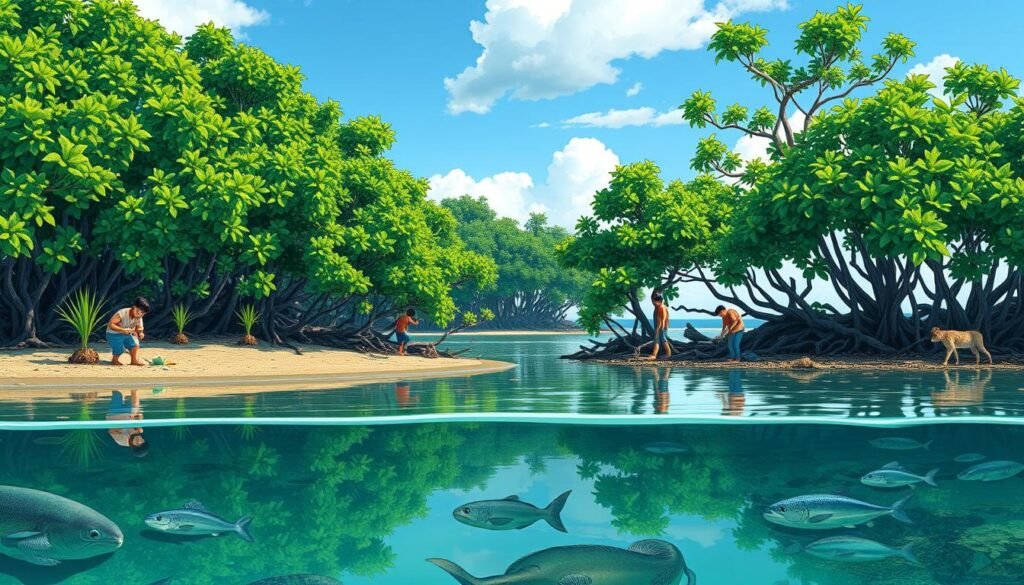
In summary, mangroves are very important in policy and planning. By adding mangroves to city plans and making policies for their care, we can protect these vital ecosystems. This helps us reach sustainable development goals.
| Mangrove Benefits | Description |
|---|---|
| Coastal Protection | Reduces erosion and storm damage |
| Biodiversity | Provides habitat for diverse species |
| Climate Change Mitigation | Sequesters carbon and reduces emissions |
Conclusion: The Way Forward for Philippine Mangroves
Exploring the role of mangrove ecosystems in the Philippines shows their importance. We must focus on saving and restoring them. These coastal habitats are key, providing vital services that protect communities and support livelihoods.
The loss of mangroves has serious consequences. It leads to more flooding, damage to properties, and affects many Filipinos’ lives. But, there’s hope in restoring and conserving these al treasures. This could lead to a more stable and prosperous future for the Philippines.
To move forward, we need a team effort. Scientists, policymakers, and local communities must work together. We should boost conservation, improve restoration, and mix old wisdom with new science. This way, we can protect these vital coastal areas for the long term.
FAQ
What are mangroves and why are they important?
Mangroves are coastal ecosystems found in tropical and subtropical areas. They have a unique root system that lets them live in salty, low-oxygen environments. These ecosystems are key for coastal health, providing homes for many species and protecting against storms and tsunamis.
What is the current state of mangrove forests in the Philippines?
The Philippines has many mangrove ecosystems, but they face threats like deforestation, climate change, and pollution. It’s important to tackle these issues to protect mangroves for future generations.
What is the unique biodiversity of Philippine mangroves?
The Philippines boasts a diverse range of mangrove species, including some found nowhere else. These ecosystems support a wide variety of plants and animals. Preserving this biodiversity is vital for the health of mangrove ecosystems and the species that depend on them.
What ecosystem services do mangroves provide?
Mangroves are vital for our planet, supporting biodiversity and human well-being. They help in the global carbon cycle, sequestering carbon dioxide and fighting climate change. They also protect coastlines from erosion, reducing disaster risks and supporting coastal communities.
How do mangroves contribute to the economy?
Mangroves are essential for the global economy, providing services that support human livelihoods. They are a key source of food and income for coastal communities, supporting fisheries, aquaculture, and ecotourism.
What are the main threats to Philippine mangroves?
Philippine mangroves face threats like deforestation, land development, climate change, pollution, and waste management issues. Rising sea levels and more frequent storms put pressure on these ecosystems. Pollution and waste management also harm mangroves.
What is the conservation status of mangroves in the Philippines?
The conservation status of mangroves in the Philippines is complex. There are protected areas and initiatives to support conservation. Local communities, government policies, and regulations play key roles in conservation efforts.
What are some successful mangrove restoration efforts?
Restoration efforts are vital for mangrove ecosystems. Successful projects range from small community-led initiatives to large government-funded efforts. Community engagement is key for restoration success.
How do mangroves contribute to climate change mitigation?
Mangroves play a critical role in mitigating climate change. They sequester carbon dioxide, supporting global efforts to reduce greenhouse gas emissions. They are a vital component of the global carbon cycle.
What is the role of traditional knowledge in mangrove management?
Traditional knowledge is essential for mangrove management. It offers a unique perspective on human-environment relationships. Indigenous practices have managed mangroves for centuries, playing a vital role in conservation. Integrating traditional knowledge with modern science is critical for sustainable management.
How can education and awareness initiatives promote mangrove conservation?
Education and awareness are key for mangrove conservation. They lay the groundwork for effective management and community engagement. NGOs play a vital role in advocacy and education, supporting community-led initiatives.
What is the importance of mangroves for coastal resilience?
Mangroves are vital for coastal communities’ health and well-being. They provide ecosystem services that support biodiversity and livelihoods. They are essential for coastal resilience, reducing disaster risks and supporting climate adaptation.
What are the challenges and opportunities for the future of mangroves in the Philippines?
The future of mangroves in the Philippines is uncertain, facing challenges and threats. Yet, there are opportunities for sustainable development. Addressing these challenges and supporting sustainable management practices is essential for mangrove conservation.
How are mangroves incorporated into policy and planning?
Mangroves are vital in urban planning, providing ecosystem services that support biodiversity and livelihoods. They should be included in planning initiatives to reduce disaster risks and support climate adaptation. Policies supporting sustainable mangrove management are essential for conservation and community support.
Source Links
- Mangrove Forests in the Philippines – https://maritimereview.ph/mangrove-forests-in-the-philippines/
- The importance of Philippine mangroves – https://www.pna.gov.ph/opinion/pieces/888-the-importance-of-philippine-mangroves
- Beneath the tides and behind the timbers: Marvels of Philippine Mangroves – https://climate.gov.ph/news/902
- Mangroves – https://ocean.si.edu/ocean-life/plants-algae/mangroves
- Introductory Chapter: Mangrove Ecosystem Research Trends – Where has the Focus been So Far – https://www.intechopen.com/chapters/63980
- Microsoft Word – Mangroves_Introduction_Article 1.docx – https://wgbis.ces.iisc.ac.in/biodiversity/sahyadri_enews/newsletter/issue40/article1/mangroves_introduction.pdf
- Mapping the Philippines’ Mangrove Forests Using Landsat Imagery – https://pmc.ncbi.nlm.nih.gov/articles/PMC3231605/
- Mangrove Forest Ecosystem Services — The Marine Diaries – https://www.themarinediaries.com/tmd-blog/mangrove-mania-the-ecosystem-that-keeps-on-giving
- Ecosystem Services of Mangrove Forests: Results of a Meta-Analysis of Economic Values – https://pmc.ncbi.nlm.nih.gov/articles/PMC7459810/
- Ecosystem services – https://www.fao.org/forestry/mangrove/ecosystem-services/en
- Benefits of Mangroves – Socio-economic — The LEAF Charity – https://www.theleafcharity.com/blog/benefits-of-mangroves-socio-economic
- Mangroves Are More Valuable Untouched | PlasticOceans.org – https://plasticoceans.org/studies-show-mangroves-offer-an-economic-benefit/
- What are mangroves worth? There’s no easy answer – https://iucn.org/news/forests/201704/what-are-mangroves-worth-there’s-no-easy-answer
- Missing mangroves are root of contention over Philippine airport project – https://news.mongabay.com/2020/09/missing-mangroves-are-root-of-contention-over-philippine-airport-project/
- Mangroves | ZSL – https://www.zsl.org/what-we-do/projects/mangroves
- PDF – https://www.muzeulbrailei.ro/uploads/img/stiintele-naturii/Volume 12/03JWB2022125165.pdf
- Best Practice Guidelines for Mangrove Restoration – The Mangrove Alliance – https://www.mangrovealliance.org/best-practice-guidelines-for-mangrove-restoration/
- Mangrove restoration: the latest best-practice approaches – Wetlands International – https://www.wetlands.org/mangrove-restoration-the-latest-best-practice-approaches/
- Mangrove ecosystems’ role in climate change mitigation – https://ejournals.ph/article.php?id=23387
- Mangroves Mitigate Effects of Climate Change Provide Local Economic Benefits – https://www.pewtrusts.org/en/research-and-analysis/articles/2021/07/21/mangroves-mitigate-effects-of-climate-change-provide-local-economic-benefits
- Indigenous Stewardship Brings Restoration of Mangroves – https://www.culturalsurvival.org/publications/cultural-survival-quarterly/indigenous-stewardship-brings-restoration-mangroves
- Local Ecological Knowledge (LEK) in Mangrove Conservation – https://www.linkedin.com/pulse/local-ecological-knowledge-lek-mangrove-conservation-mark-spalding-uposf
- Sustainable mangrove rehabilitation: Lessons and insights from community-based management in the Philippines and Myanmar – https://www.apn-gcr.org/bulletin/article/sustainable-mangrove-rehabilitation-lessons-and-insights-from-community-based-management-in-the-philippines-and-myanmar/
- Education, Awareness and Capacities to Achieve the Goal of Mangrove Restoration – https://iki-alliance.mx/en/education-awareness-and-capacities-to-achieve-the-goal-of-mangrove-restoration/
- PDF – https://journals.e-palli.com/home/index.php/ajth/article/download/1748/799/10095
- Open Access proceedings Journal of Physics: Conference series – https://iopscience.iop.org/article/10.1088/1755-1315/1266/1/012029/pdf
- How mangroves provide coastal resilience in the Global South | One Earth – https://www.oneearth.org/how-do-mangroves-provide-coastal-resilience-in-the-global-south/
- Preserving Mangroves to Enhance Coastal Resilience – https://www.wacaprogram.org/article/preserving-mangroves-enhance-coastal-resilience
- Uncertain future looms for Philippine, Southeast Asian mangroves – https://science.upd.edu.ph/uncertain-future-looms-for-philippine-southeast-asian-mangroves/
- Securing the future of mangroves for local communities – Restoration Stewards by Global Landscapes Forum – https://stewards.globallandscapesforum.org/peatlands-wetlands/503/securing-the-future-of-mangroves-for-local-communities/
- Policy Recommendations on Management of Mangroves – https://www.pcpd.ph/images/Characterization_of_Mangrove_Areas_and_Profile_of_Human_Activities_in_SANPASADA_case_study.pdf
- Management – https://www.fao.org/forestry/mangrove/management/en
- #Obj#285_0 – https://www.wavespartnership.org/sites/waves/files/kc/Policy Brief Valuing Protective Services of Mangroves in the Philippines.compressed.pdf
- Healthy mangroves build a resilient community in the Philippines’ Palawan – https://news.mongabay.com/2022/08/healthy-mangroves-build-a-resilient-community-in-the-philippines-palawan/

